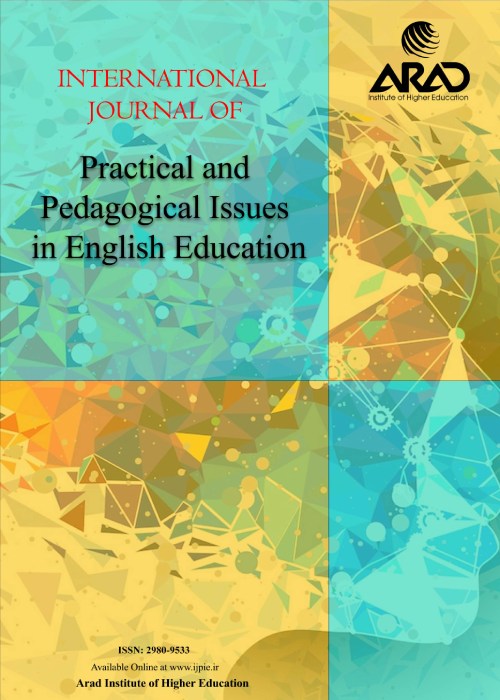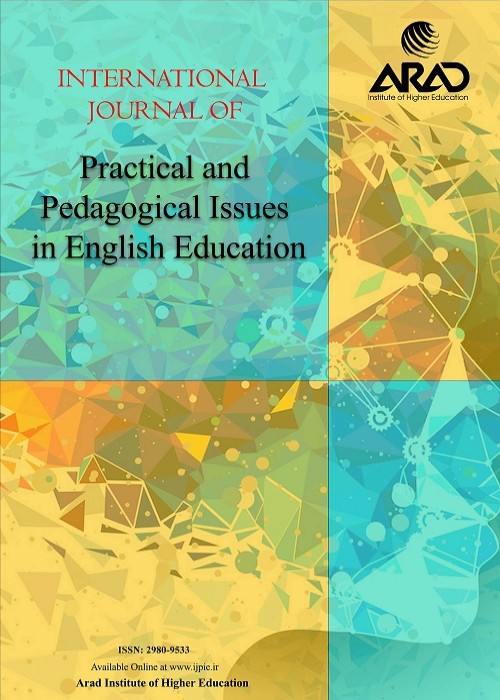فهرست مطالب

Journal of Practical and Pedagogical Issues in English Education
Volume:1 Issue: 2, Jun 2023
- تاریخ انتشار: 1402/03/31
- تعداد عناوین: 6
-
Pages 1-14
Learning a foreign language, English in this context, and communicating in that language can be an anxiety provoking experience for learners. In other words, language anxiety is a major potential factor affecting EFL learners’ willingness to communicate (WTC). In this study, the researcher made an attempt to fulfill the following purposes a) the correlation between foreign language anxiety (FLA) and WTC of the students, b) the reasons of FLA among EFL learners, c) the ways to get rid of FLA, and d) the reasons of students’ reticence in English classes. For this purpose, 60 university EFL learners within the age range of 18-22 filled out two questionnaires of Foreign Language Classroom Anxiety Scale and Willingness to Communicate questionnaire. Also, the participants were asked to provide their ideas about the reasons of anxiety and reticence in EFL classes. In order to find the possible relationship between students’ FLA and WTC, one set of Pearson Product correlation analyses was run, the findings of which revealed that there existed a strong negative relationship between EFL learners’ FLA and WTC indicating that students who had high level of anxiety, tended to have low desire to communicate. Moreover, quantitative descriptive approach was used to examine learners’ perspectives towards the two concepts. Teachers’ negative evaluation was the predominant reason of anxiety among learners. Also, the participants believed that EFL teachers have the most important role in easing the level of anxiety by creating a friendlier relationship and less negative evaluation. The choice of topic was also known as the most important reason of reticence among EFL learners. The findings of this study highlight the fact that language anxiety is a great barrier to WTC.
Keywords: EFL learners, Foreign language anxiety, willingness to communicate -
Pages 15-28
Teaching English in Iran faces challenges due to the environmental and interactive situations with which the language learners are facing outside the language learning classes. Considering the teaching methodology in Iranian schools and the insist of the governmental and private language institutes on CLT and TBLT, prerequisite conditions for effectiveness of such methodologies seem to be unavailable or not made available for the learners. CLT and TBLT methodologies mainly focus on speaking and oral activities in the classroom. In the domain of language learning and usage, speaking ability is considered as the most challenging among other three language abilities. Hence, an alternative approach for teaching and learning language seems to be needed. There are also criticisms on the mentioned methodologies; an important one among them is the increased amount of errors in learners’ oral utterances. On the other hand, critical thinking and figurative thinking abilities’ importance for using the language and the speaking ability is being focused and these thinking abilities are considered to have direct correlation with learners’ speaking abilities. Writing activities in different pedagogical areas are used to improve learners’ critical thinking, however utilizing such approach for learning language is a matter that is not studied. This research studies a teaching approach with a focus on written language and hoped to help learners figure out and understand language elements clearly, and use them to excel their speaking proficiency. This approach includes written tasks defined to help learners “see” the language elements and argue about them. The session plan is, to guide students learn the language via the written tasks and use what is learned orally in a similar context, based on Harmer’s ESA approach and TBLT methodology. In the end of the research, speaking achievement of the learners will be assessed to evaluate the teaching approach’s efficiency.
Keywords: ESA, lesson planning, speaking, Task-based language teaching -
Pages 29-34
This research aimed to compare Korean and Persian languages both in syntactic and morphological phases. Based on research questions, this research used qualitative approach to figure out and explore the specific detailed information about the topic. The present article seeks to briefly compare some of main similarities and differences of target languages. The researcher used previous studies and researches about each of Korean and Persian syntactic morphological features. In this qualitative case study a total of 22 researches and books were used to collect data about syntactic morphological features of Korean and Persian languages in this research. No research, to date, compared these linguistic elements of Korean and Persian. In general, there are some similarities and differences between syntax and morphology of these Asian languages. A comparative study on these structures is useful because it can help Iranian KFL learners to enhance the process of learning Korean language.
Keywords: Korean, Persian morphological typology, Persian syntactic typology, Linguistics, Korean language, Persian language -
Pages 35-41
The study investigates the two novels of Jane Ayre and The Bell Jar, the aspects focus on the psychological matters. These matters are like mental instability and behavioural instability, also the madness. The forms of mental illnesses are many, the ones those are known commonly are linked to women as long as these women are not obedient. The mental instability occurs to several reasons and these reasons are mostly through the life of the women who face such conditions. The reasons are like the imprisonment of women and being locked. The other aspect is the role of the psychological pressure women suffer of and these psychological pressures are made of forms those are different.
Keywords: Instability, mental illness, Psychological Problems -
Pages 42-48
As mentioned clearly in the book, the intended audience is third-year (or above) undergraduate and postgraduate students (e.g. masters and doctoral students) in Applied Linguistics, TESOL and Second Language Studies. The book is correspondingly appropriate for experienced researchers wishing to develop their knowledge in research areas they are less familiar with. It is furthermore intended as a resource for research supervisors and educators to recommend to their students for information and advice on possible research designs and potential investigation subjects.
-
Pages 49-51
Second Language Research: Methodology and Design (Third Edition) is a comprehensive resource for students and researchers conducting studies on second language learning. It deals with the basics of the field as well as the broader issues in applied linguistics.


